Contents
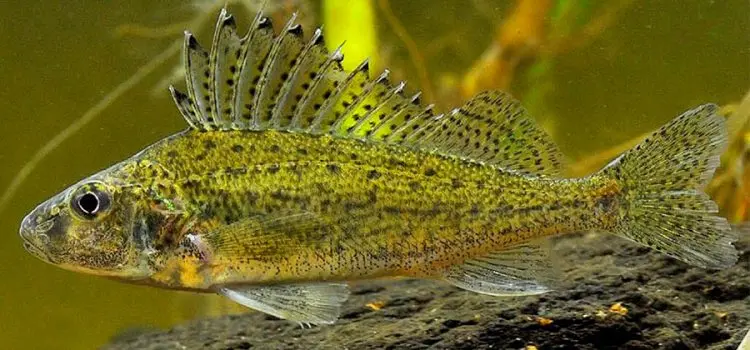
The common ruff represents the perch family and the unique genus Gymnocephalus, which includes 4 species of ruffs. Close relatives of the ruff can be considered perkarins, chop, pike perch, ammacrinths, peppers and perches. As a rule, individuals grow in length up to a maximum of 12 cm and weigh no more than 25 grams, although in exceptional cases there are specimens up to 20 cm long and weighing up to 100 grams.
The maximum life expectancy of ruffs is about 10,5 years, and the average is no more than 6 years. Because of its uniqueness, it has several unpleasant names: annoying, prickly, snotty.
What does ruff look like

Due to the structural features of the body, ruffs are difficult to confuse with other types of fish, and here’s why:
- The ruff has a large head, which occupies up to 30% of its body.
- The body is torpedo-shaped, somewhat flattened and covered in mucus.
- The eyes are large, pale pink, and the mouth has bristle-like teeth.
- The gill covers are wide and prickly.
- The scales are small, but dense, with ridges and teeth along the trailing edge.
- The lateral line is located along the entire length.
- The dorsal fin is fused and has several height differences.
Ruffs have a camouflage coloration of the back, a gray-green hue with dark spots, while the abdomen is light gray, and the sides are yellowish-golden in color. Black dots are densely scattered over the entire surface of the fins. Coloration may vary slightly from the base, depending on the characteristics of the habitat.
Types and geography of their settlement
Ruff is an unpretentious fish and feels good both in cool and warm water. In this case, the ruff selects areas of the reservoir with a sandy, rocky or slightly muddy bottom. The fish is quite demanding on the concentration of oxygen in the water, as well as on the intensity of the current. The predator does not like areas with stagnant water, shallow water, and fast currents. Such restrictions leave their mark on the habitat of ruffs. Therefore, fish can be found in large and small rivers, in canals, in reservoirs, in lakes and ponds, but with running water.
Due to the fact that the ruff can withstand significant changes in water temperature, it is found almost everywhere. Ruff inhabits all water bodies included in the basin of the Baltic, Black, Azov and Caspian Seas. Other species, compared to common ruff, inhabit water bodies located in regions with warmer winters.
Donskoy ruff

This species is better known by other names, such as privet, beaver or nosari. Inhabits water bodies of the Black Sea-Azov basin. Significant populations of this species live in Europe, in such rivers as the Southern Bug, Dnieper and Dniester. It differs from its relatives with a wedge-shaped head and an elongated snout. The mouth of this species is retractable, the abdomen is white, and the back is light yellow. It grows in length up to 20 cm and gains weight up to 200 grams. In Ukraine, it is considered an endangered species, therefore it is listed in the Red Book.
Ersh Baloni
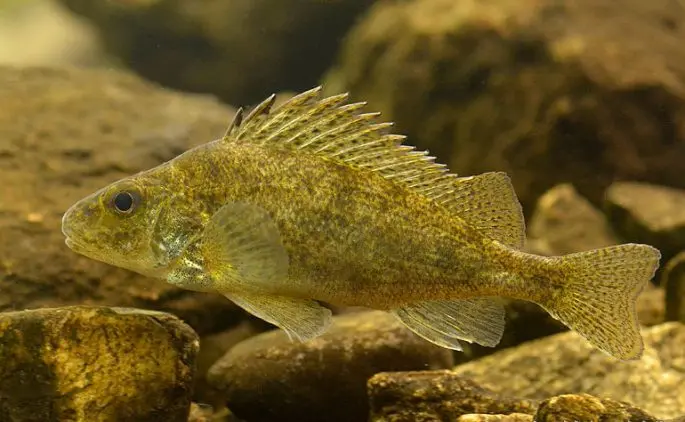
This type of ruff prefers to be in deep areas with running water, in close proximity to the coastline with high steep banks in the shade. Dislikes areas with soft bottoms, therefore keeps to areas with sandy, clay or gravel bottoms, as well as mixed areas. The life span of the species is about 6 years. During this period, the fish grows in length up to 17,5 cm, while gaining a weight of about 45 grams. It also has a second name – Czech ruff, since it is found in the basins of the Morava, Vltava, Laba rivers. The taxon is also found in the Danube, Dnieper and Pripyat rivers. It differs from its relatives in a more humpbacked body, a short but flattened snout, two spines on each gill cover, and also, a unique tiger gray-yellow color.
striped ruff
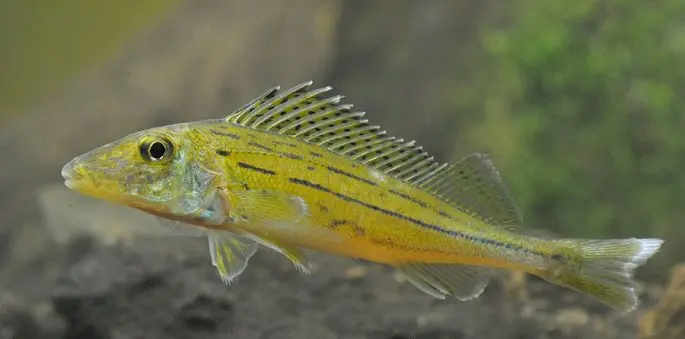
This type of ruff is more impressive in size, as it grows to almost 30 cm in length, with a weight of about 250 grams. At the same time, fishermen’s catches are dominated by individuals no more than 18 cm in length and weighing about 70 grams. It is found in water bodies of Germany, Bulgaria and Ukraine. The main difference is the presence of 3-4 full or dotted stripes running along the body and located on the sides, which have an olive-yellow tint. The mouth is semi-inferior, retractable, and the snout is slightly elongated. The dorsal fin is fused and has up to 19 hard rays.
Black Sea scorpion ruff
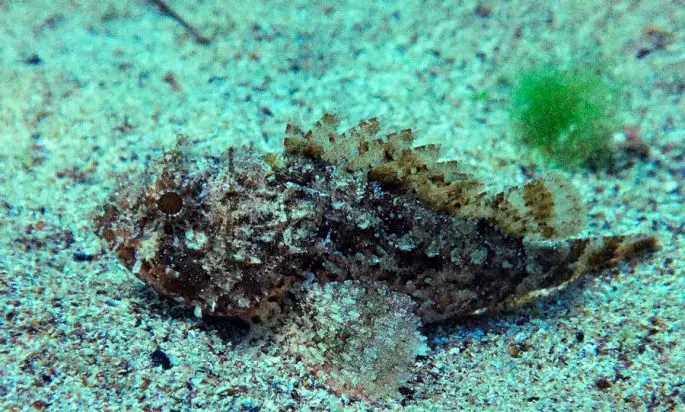
This type of ruff represents the genus of scorpionfish and differs in only one similarity with lake-river counterparts – a set of spines. It is found exclusively in salt water and belongs to rather tough predators. This ruff has a huge mouth, and the lower jaw is somewhat elongated. As it develops, this fish sheds its skin like a snake, which becomes tight for the predator. Another rather important feature is that the ruffs of this species have poison in their fins and bone spikes. It can grow up to 40 cm in length, while gaining a weight of about 0,8 kg. The main populations of the Black Sea ruff are located in the salty waters of the Eastern Atlantic, as well as in the waters of the Black, Azov and Mediterranean seas. The Black Sea ruff has quite tasty and healthy meat, if it is cooked correctly.
Where does the ruff live and what does it eat

Ruffs adhere to areas with a depth of 1 to 3 meters, which are distinguished by a sandy-clay or gravel bottom. At the same time, ruffs try to be close to natural shelters, represented by large stones, vegetation, bushes, snags, driftwood, etc. The fact is that this fish is included in the diet of many predatory fish species. And this is not just an object of food for them, but a favorite delicacy.
There are a number of factors to consider when choosing a promising site. This fish does not like direct sunlight, therefore it prefers to be in the shade, as well as in water areas that are cooled by underwater springs. The thing is that the ruff leads a benthic lifestyle and feels great in complete darkness. Almost throughout the season, this fish is active early in the morning, late in the evening or at night. If it is cloudy and cold outside, then ruffs are looking for food around the clock, including during the day. Such weather conditions make it possible to fish both during the day and at other times of the day. The basis of the diet of ruffs is made up of various living organisms, leeches, worms, caviar of other fish, etc. Adults do not disdain tadpoles and fry of other fish species.
Interesting to know! Ruff can hardly be called a predator, since it eats not only fish. This is an omnivorous benthophage, which is food competition not for pike or pike perch, but for roach, crucian carp, scavenger, gudgeon, etc. The increase in the number of ruffs in the reservoir leads to a decrease in the number of many carp fish species.
Spawning

Individuals become sexually mature when their body length averages 10 cm. This can happen even a year after birth. It all depends on the availability of a food base and the growth rate of individuals. The older the female, the more eggs she lays. Therefore, their number varies between 10-200 thousand. Caviar is rushed in several stages, which stretch in time from March to June. Water temperature is of secondary importance. Eggs can develop in a wide range of temperatures, from 6 to 18 degrees. At the same time, caviar ripens in a maximum of one and a half weeks. What is interesting is that ruffs can live in waters with high acidity, which allows this fish to survive in conditions in which other types of fish simply die.
The size of the caviar is not more than 1 mm. It is deposited on a solid base, which can be the bottom of a reservoir or the underwater parts of plants. The caviar is quite sticky and has a yellow color. For spawning, females choose areas of the reservoir, with a depth of no more than 2 meters. What is interesting is that the males stay at the clutches to protect their offspring from enemies. The larvae that were born for some time continue to be at the spawning site, where they develop due to the yolk sac. Having gained strength, they set off for free swimming, where they begin to feed on zooplankton and other small food objects.
What does the ruff peck at in summer and winter
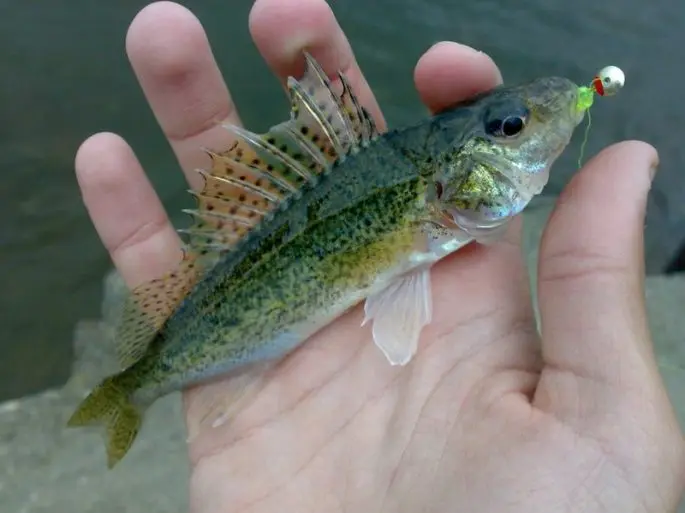
In the summer, the following baits are used to catch ruffs:
- Earth and dung worms.
- Maggot, bloodworm, caddisfly.
- Fish eye.
- Bark beetle or burdock moth larvae.
To catch this fish, a regular float rod is used, with a 0,2 mm line so that it can withstand hooks. The fish is not big, so sensitive equipment is needed. As a rule, sensitive floats, such as “goose feather”, are used. Ruff takes the bait greedily, so hooking must be done in a timely manner, otherwise he will swallow the hook almost into the stomach. This behavior does not make it possible to use the ruff as a live bait.
Ruff fishing in winter
Ruffs do not show activity except in the dead of winter, so it can be caught all winter. Flocks of this fish search the bottom around the clock in search of food, so the fish are caught on a nodding winter fishing rod. In this case, a fishing line is used, with a thickness of not more than 0,1 mm, with a mormyshka of not large sizes, with replanting bloodworms, maggots or a piece of worm. As bait, any bait with the addition of chopped bloodworm is used. Ruff is better to catch in the morning and in the evening.
Taste and energy value
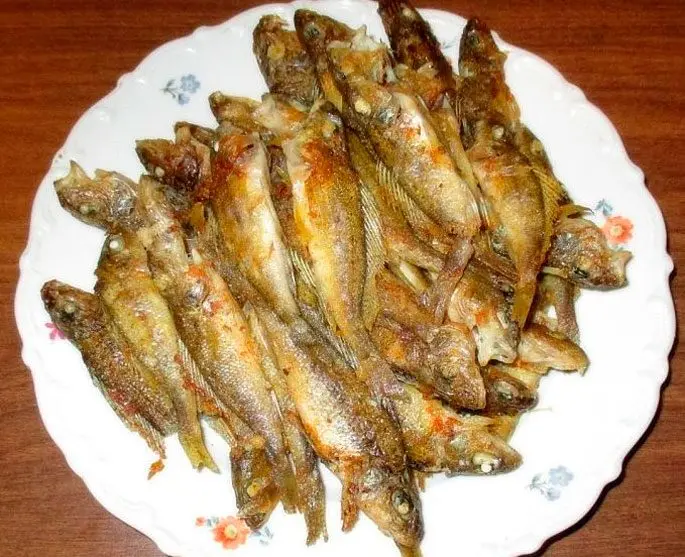
Ruff meat is a low-calorie product, with an energy value of about 88 kcal per 100 grams of product. This makes the fish indispensable for dietary nutrition. In addition, fish meat contains a high content of easily digestible protein and other useful components, such as vitamins of the PP, A, E, etc. groups. Moreover, meat contains a whole complex of amino acids, as well as trace elements such as phosphorus, fluorine, chromium, molybdenum and others.
This fish can be fried, baked, stewed and boiled. Ruffs are considered an excellent basis for cooking fish soup and other dishes. You should always remember that the most useful fish is boiled. No less popular technology is drying technology. With this technology, the fish is the most useful, since it retains almost all useful substances. The drying technology is quite simple: chopped fish carcasses are placed in salt, and there should be a lot of salt. The fish is laid in layers, after which oppression is placed on top. In this state, the fish should be up to 5 days, after which the carcasses are removed and soaked in water to get rid of excess salt. After that, the fish is dried in the shade for one week.
In conclusion
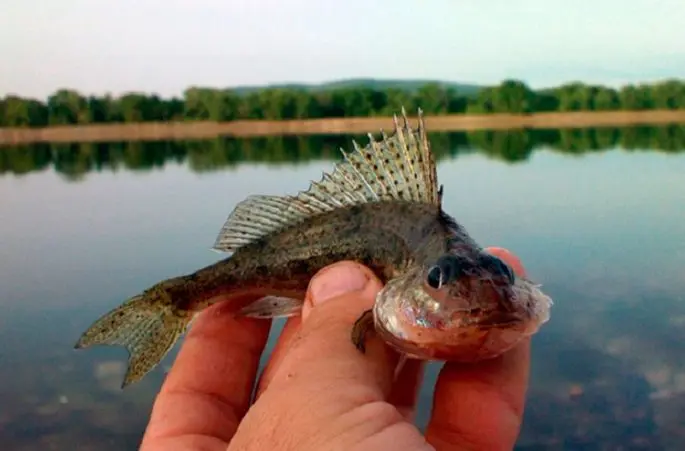
Few people are engaged in purposefully catching ruffs, and many anglers call this fish weed. With ruffs there are only problems. Firstly, this fish is quite prickly, and secondly, it greedily swallows the bait along with the hook, after which you have to conjure how to pull out this hook. As a rule, after such an operation, the fish dies. Despite this, many anglers know that ruff is the basis of fish soup and are happy to use them to cook it. The result is a rich and tasty ear. Ruff meat has a pleasant sweetish taste, so the fish soup is excellent.
Unfortunately, ruff suffers the same fate as many other types of fish. Due to the constant pollution of water resources, even ruff populations are declining, which leads to a violation of the natural balance. As a result, the number of predatory fish whose diet includes ruffs is decreasing. It turns out that in nature everything is interconnected, which people often forget about.
Catching a large ruff on the Volga









